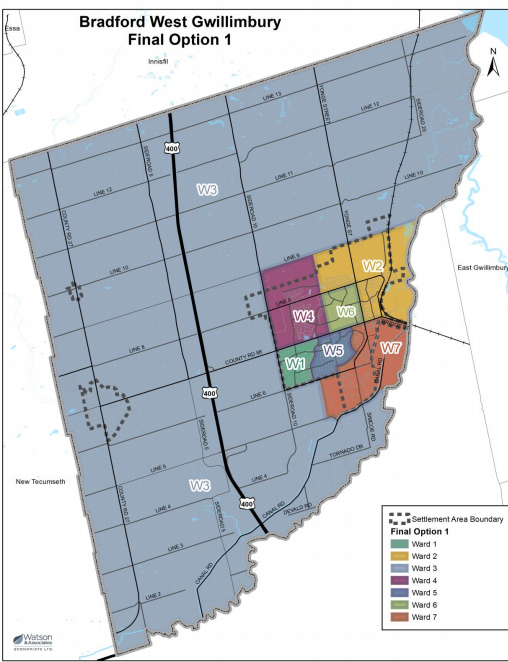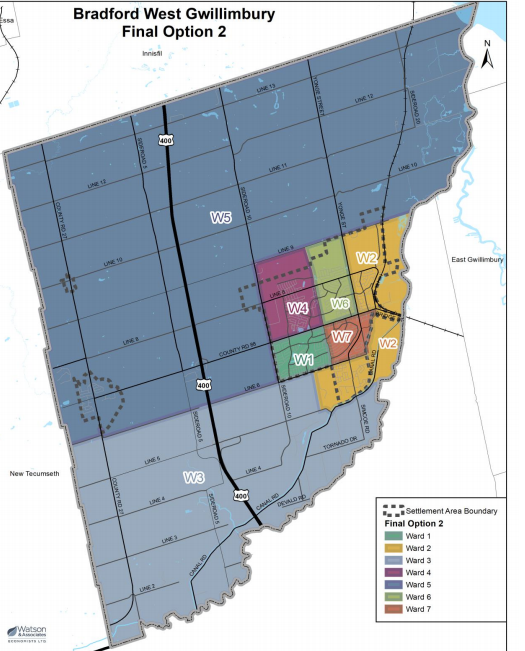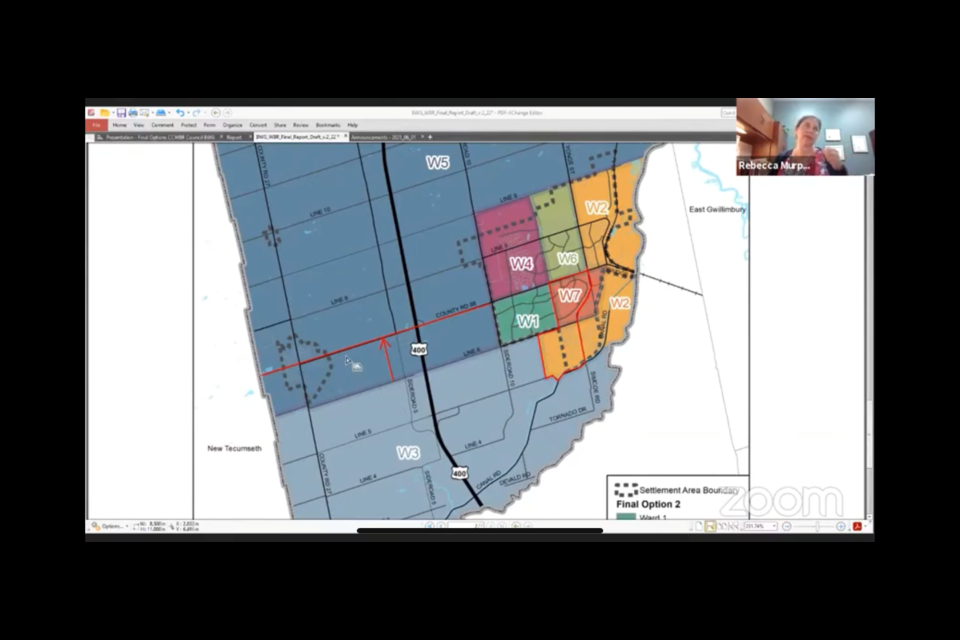In Tuesday night's Committee of the Whole meeting, councillors received a final report on the town's Ward Boundary Review, which presented two options for council to consider.
The options were brought forward in a presentation by Jack Ammendolia of Watson & Associates Economists Ltd. and Dr. Robert Williams.
The review was conducted to look at the town's current council composition and ward boundaries. The objective was to ensure fair and equitable representation of the residents at town council.
The new ward boundaries would take effect in 2022, ahead of the next municipal election, and remain until the next ward boundary review in 2031.
The last ward boundary review was conducted in 2009, and the town has grown substantially since then. The current council composition includes one mayor and one deputy mayor role representing the population at large, and seven ward councillors.
As it stands, the wards do not provide effective representation based on some of the guiding principles identified by the consultants.
- Effective representation
- Representation by population
- Representation of communities of interest
- Population and electoral trends
- Geographical and topographical features as boundaries
In addition to the six preliminary options presented to council in April, the consultants also considered council size and composition, such as having more or less than seven wards, and the method in which the deputy mayor position is elected.
The two new ward boundary options include:
Final Option 1
 Ward Boundary Option 2. By Screenshot
Ward Boundary Option 2. By ScreenshotThis set-up would have seven ward councillors in a six urban, one rural ward makeup. All wards have good population parity.
The design would feature one ward councillor for the entire rural area of Line 14 to the north, Highway 27 to the west, and into the Holland Marsh area.
This option focuses on growth and population trends.
"BWG has been and continues to urbanize at a rapid pace," said Ammendolia. As noted in the report, the 'trade off' for this option, is a loss of representation on council for the rural area.
"From a population parity perspective, all the wards population are within our 25 per cent acceptable range," he said of the first option.
Final Option 2
 Ward Boundary Option 1. By Screenshot
Ward Boundary Option 1. By Screenshot
This option is similar to the current ward boundary system which residents are familiar with. This set-up would have the same seven ward councillors, with five in the urban area and two representing the rural.
The urban settlement area is divided into five wards, with four arranged in a quadrant pattern with clear boundary lines using major arterial roadways.
The representation by population is somewhat successful with two rural wards.
As per the report, the population balance in the five urban wards would be reasonable in 2021, but get better in 2031.
After reviewing the report, councillors had to decide whether to:
- Change the composition of the nine-member council to another number
- Modify the way the deputy mayor role is filled. Currently, the role is filled by general vote, but council is also able to select the role which can be a way to add an eighth ward councillor or as a way to reduce the overall composition of council.
- Adopt one of the final two options
- Take no action at all
Most councillors were in favour of adopting Option 2, with some modifications.
"I think Option 2 better maintains the communities of interest within urban Bradford," commented Ward 2 Coun. Jonathan Scott. "Option 1 feels like we are shoving Ward 5 into the centre of town and pushing out Wards 7 and 2 from where they currently are."
Scott not happy with the new proposed boundary line between Wards 2 and 7 from Simcoe Road to Marshview Road.
"Between Ward 2 and Ward 7, could we not keep a straight boundary at Simcoe Road rather than the zigzag at Marshview?" Scott asked the consultants.
"We are trying to keep those neighbourhoods somewhat together on the side of Simcoe and Walker," explained Ammendolia, but that by keeping the boundary at Simcoe Road it swung the population balance, adding about 2,300 extra residents to Ward 2's population.
Having Marshview as the boundary line to the east would lower that number to approximately 1,000 people, but would still be acceptable to keep it status quo if council agreed.
Coun. Scott, and Ward 7 Coun. Peter Dykie, said they would prefer to have the boundary line kept at Simcoe Road, noting the new subdivisions being built near Sixth Line could help balance the population parity.
Ward 3 Coun. Gary Lamb agreed with Scott and Dykie about keeping Simcoe Road.
But Ammendolia confirmed by 2031, this would not be optimal from a population perspective, resulting in Ward 7 having a lower population.
Mayor Rob Keffer wondered why there was no option of moving part of the overpopulated neighbouring Ward 1 into Ward 7 for better balance.
"I can't understand why you haven't figured this out," he told the consultants. "Quite frankly, I'm very disappointed about this report, it just doesn't make sense at all any of the lines that you've drawn."
"I don't think you have an understanding of the community," he said, suggesting a major change to the wards is not necessary.
Ammendolia assured council all options suggested had been considered with feedback taken from the public.
Ward 4 Coun. Ron Orr was not in favour of merging the two rural wards in Option 1.
"I think that would be a problem for the rural population to be not properly represented," the councillor said.
Ward 1 Coun. Raj Sandhu and Ward 6 Coun. Mark Contois preferred Option 2 but had some concerns about representation by population.
"I get that you want to have rural and urban, but at the end of the day you're representing folks," noted Contois.
Contois was happy with Ward 6's proposed boundary, saying it "made sense", bringing numbers to where they needed to be.
Ward 5 Coun. Peter Ferragine was not a fan of either option and wanted to see more mixed wards of urban and rural components.
"The rural population is not going to be heard," he said. "I feel it's very one-sided, I don't like the way it's laid out."
But Ammendolia warned the mixing of rural and urban could be "dangerous" and that the rural voice would be drowned out.
Deputy Mayor James Leduc commended the work gone into the report, which focused on representation by population.
"The size of the ward doesn't matter," he said. "At this level, we represent our residents and it should be fairly represented...everyone gets a voice."
Leduc supported Option 1, noting the numbers were "perfect", but agreed to endorse Option 2 if tweaks were made.
Council approved Option 2, with an amendment to have the boundary line between Ward 2 and 7 moved back to Simcoe Road, and the boundary line between Ward 3 and 5 up to County Road 88, with south of County Road 88 part of Ward 3, and everything north Ward 5.
The report will come back to council on June 23, with updated data from the amendment.
To view the final report with Option details, click here.



